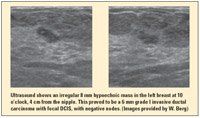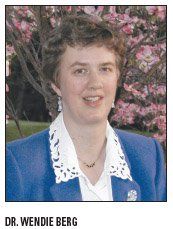Breast US finds cancer that mammo misses in at-risk pts
Screening ultrasound paired with mammography upped breast cancer detection in high-risk women with dense breasts, but the combination also caused a spike in the number of false positives, according to an update of the ACRIN 6666 trial. These results, along with other barriers, may render ultrasound less attractive than MRI in this patient population, commented a breast imaging expert.
ABSTRACT: ACRIN results also expose cons to sonography screening: high false-positive rate, lengthy exam time, and the need for special training.
Screening ultrasound paired with mammography upped breast cancer detection in high-risk women with dense breasts, but the combination also caused a spike in the number of false positives, according to an update of the ACRIN 6666 trial. These results, along with other barriers, may render ultrasound less attractive than MRI in this patient population, commented a breast imaging expert.

In the ongoing trial, women with dense breast tissue in at least one quadrant were scanned at 21 sites; 2,637 have completed at least 12 months of follow-up. More than half (53%) had a personal history of breast cancer, reported Wendie Berg, MD, PhD, and colleagues (JAMA 299:2151-2163, 2008). Dr. Berg is from American Radiology Ser vices, Johns Hopkins Green Spring, Lutherville, Maryland. ACRIN 6666 was funded by the Avon Foundation and the National Cancer Institute.
Cancer was detected in 41 breasts in 40 women: 8 of the cancers were found with mammography plus ultrasound, while 12 were deemed suspicious on ultrasound alone, 12 on mammography alone, and 9 on neither. Of the 12 sonographically detected cancers, 11 (92%)

were invasive. The diagnostic yield for the combined modalities was 11.8 per 1,000 vs 7.6/1,000 for mammography alone. Diagnostic accuracy was 91% for mammography plus ultrasound vs 78% for mammography alone.
On the downside, for combined imaging, the false-positive rate jumped to 10.4% vs 4.4% for mammography alone.
Other issues with ultrasound: The median examination time was 19 minutes, and current Medicare reimbursement rates do not cover the costs of performing and interpreting the examinations, the authors wrote.
Time consuming?
In a JAMA editorial, Christiane Kuhl, MD, of the University of Bonn, Germany, pointed out the high personnel cost of ultrasound may render MRI the better bet. “Due to the amount of physician time screening ultrasound requires, it may be the most expensive of all breast imaging modalities,” she wrote.
In an interview, Dr. Berg countered that the overall price of MRI studies, including the cost of contrast agent, may tip the balance in favor of ultrasound.
She also noted that the ACRIN study has yielded materials to train specialized technologists in breast ultrasound. “Methods of automated breast ultrasound (where a series of images is obtained for later review) may solve many of these issues, but such technology requires further validation at this time,” she said.
The American Cancer Society has recommended MRI for certain women at very high risk of

breast cancer, including known or suspected BRCA gene mutation carriers, Dr. Berg said. “If MRI is performed, ultrasound screening is not necessary,” she said..
Based on their individual risk factors, she said, for many women, ultrasound may be a reasonable alternative to MRI, or MRI may not be available or tolerable. “MRI may not be warranted in some women with a personal history of breast cancer, prior atypical biopsy, dense breast tissue, or intermediate family history,” she said.
ACRIN 6666 participants concluded a third round of sonographic screening in March 2008. Many also will undergo breast MRI to compare all three modalities.
Newsletter
Stay up to date on recent advances in the multidisciplinary approach to cancer.
Elevating the Quality of Cancer Care via Cross-Department Collaboration
Experts from Sibley Memorial Hospital discuss how multidisciplinary work has enhanced outcomes such as survival and resource use at their institution.